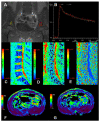Imaging Techniques and Clinical Application of the Marrow-Blood Barrier in Hematological Malignancies
- PMID: 38201327
- PMCID: PMC10795601
- DOI: 10.3390/diagnostics14010018
Imaging Techniques and Clinical Application of the Marrow-Blood Barrier in Hematological Malignancies
Abstract
The pathways through which mature blood cells in the bone marrow (BM) enter the blood stream and exit the BM, hematopoietic stem cells in the peripheral blood return to the BM, and other substances exit the BM are referred to as the marrow-blood barrier (MBB). This barrier plays an important role in the restrictive sequestration of blood cells, the release of mature blood cells, and the entry and exit of particulate matter. In some blood diseases and tumors, the presence of immature cells in the blood suggests that the MBB is damaged, mainly manifesting as increased permeability, especially in angiogenesis. Some imaging methods have been used to monitor the integrity and permeability of the MBB, such as DCE-MRI, IVIM, ASL, BOLD-MRI, and microfluidic devices, which contribute to understanding the process of related diseases and developing appropriate treatment options. In this review, we briefly introduce the theory of MBB imaging modalities along with their clinical applications.
Keywords: MBB dysfunctions; clinical application; imaging techniques; marrow–blood barrier.
Conflict of interest statement
The authors declare no conflict of interest.
Figures


Similar articles
-
Advances in imaging techniques of the blood-brain barrier and clinical application.Curr Med Imaging. 2023 Apr 28. doi: 10.2174/1573405620666230428115403. Online ahead of print. Curr Med Imaging. 2023. PMID: 37132316
-
Tumor infiltration of bone marrow in patients with hemato-logical malignancies: dynamic contrast-enhanced magnetic resonance imaging.Chin Med J (Engl). 2006 Aug 5;119(15):1256-62. Chin Med J (Engl). 2006. PMID: 16919184
-
The role of 18F-FDG PET in the assessment of a benign hematological disorder: polycythemia.Hell J Nucl Med. 2019 Jan-Apr;22(1):4-5. doi: 10.1967/s002449910951. Epub 2019 Mar 7. Hell J Nucl Med. 2019. PMID: 30843002
-
Cytomorphological evaluation of non-haematopoietic malignancies metastasizing to the bone marrow.Am J Blood Res. 2023 Feb 15;13(1):1-11. eCollection 2023. Am J Blood Res. 2023. PMID: 36937461 Free PMC article. Review.
-
3-D Cell Culture Systems in Bone Marrow Tissue and Organoid Engineering, and BM Phantoms as In Vitro Models of Hematological Cancer Therapeutics-A Review.Materials (Basel). 2020 Dec 9;13(24):5609. doi: 10.3390/ma13245609. Materials (Basel). 2020. PMID: 33316977 Free PMC article. Review.
Cited by
-
Breaking Barriers: The Role of the Bone Marrow Microenvironment in Multiple Myeloma Progression.Int J Mol Sci. 2025 Jul 28;26(15):7301. doi: 10.3390/ijms26157301. Int J Mol Sci. 2025. PMID: 40806429 Free PMC article. Review.
References
Publication types
Grants and funding
LinkOut - more resources
Full Text Sources

